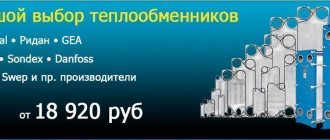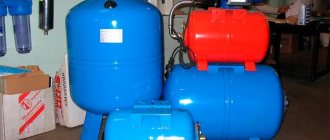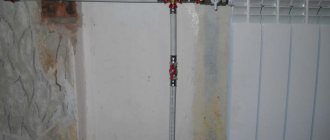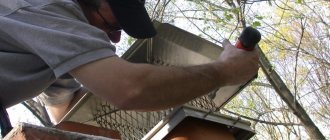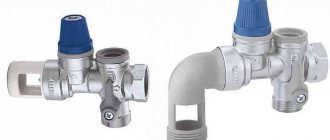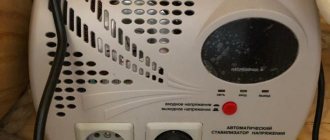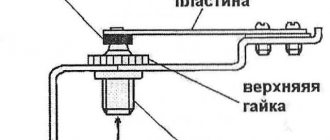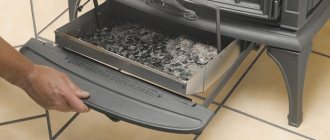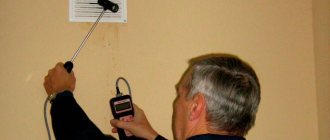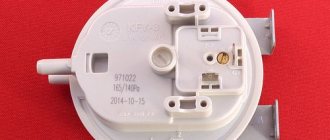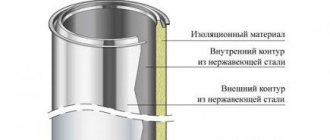What is a chimney draft stabilizer?
A draft stabilizer or interrupter is a special mechanism that performs a secondary air supply in certain doses, which makes it possible to maintain the optimal draft in the chimney for the operation of the boiler or furnace in automatic mode without human intervention. The breaker is equipped with a safety valve that prevents the creation of excess pressure.
Chimney draft stabilizers are universal, made of stainless steel and can be used with any heat-generating device, require a minimum area and are quite easy to install. The devices are able to operate at operating temperatures up to 500˚C, as well as in heating systems with condensation-type heat-generating devices, in which the temperature of the burnt gases is below the dew point.
The nuances of increasing chimney draft
Manufacturers offer 3 types of devices to optimize the gas flow rate in the chimney system:
- deflector;
- smoke fan;
- traction stabilizer.
Models of jet intensity compensators differ in the method of execution; the devices are made exclusively of stainless steel.
Deflector
The device is installed on the top line of the exhaust pipe. Models are distinguished by device:
- motionless;
- rotary (vane);
- rotating.
Due to the difference in the diameters of the body and the head, an effect occurs that stimulates air movement, since an area of low pressure is formed at the end of the pipe with a smaller diameter. The device is effective only in the presence of wind; in other cases it is useless.
Rotating deflector
Smoke fan
The unit is capable of ensuring consistently high-quality operation of the autonomous heat supply system of a private household, regardless of weather factors. The only negative is that the device runs on electricity.
Purpose of the stabilizer
The design of the smoke exhaust system largely depends on the type of heating device with which it is intended to be used. Natural temperature changes caused by weather or time of year have a noticeable impact on efficiency. Significant temperature changes during the cold season can cause the formation of high air draft in the chimney, which will cause a decrease in the efficiency of the entire system and increased fuel consumption. The draft stabilizer allows you to regulate the created pressure to the optimal value, thereby increasing the efficiency of the heating device.
Also, the draft in the smoke exhaust system is affected by atmospheric air pressure, which can be determined by the location of the house, weather conditions, time of year and day. For example, the difference in atmospheric pressure in March on cloudy weather and September on a clear day can be up to 90 Pa.
The presented video shows the principle of operation and operation of a traction stabilizer in a chimney.
Principle of operation
There are two types of traction control - automatic and manually controlled.
Reducing draft in the pipe
An automatic draft stabilizer is a kind of membrane that reacts to changes in the density of smoke in the chimney. As the draft increases, the damper opens and admits an additional flow of cold air into the pipe. This helps to cool the combustion products, the gases become heavier and rise upward more slowly, and the draft decreases.
This is interesting! Adjustment of smoke pressure occurs very quickly and the damper on the smoke regulator moves back and forth continuously. Since the part is metal, it makes a characteristic knocking noise during operation. The common people called the traction stabilizer a firecracker.
The mechanical smoke regulator is adjusted manually. To do this, there is a weight on the bottom of the regulator damper. When making a device with your own hands, it is convenient to use a regular bolt as a weight. The stabilizer is adjusted during the period of maximum fuel combustion. By tightening the bolt, the center of gravity of the damper is shifted in the desired direction so that it remains closed at the required gas pressure in the chimney, and opens when it increases.
We recommend that you read: How to make a table from a metal profile pipe with your own hands
Backdraft Prevention
The throwing of smoke into the room (backdraft) occurs when there is a sharp and significant decrease in the smoke pressure in the chimney. This happens in windy weather, when the furnace is opened, or when the outside temperature changes. The traction stabilizer reacts sensitively to these changes and blocks the flow of cold air (the damper closes completely) as soon as this happens. When the pressure rises above the desired value, the valve opens again.
Operating principle and advantages of installing a stabilizer
As soon as the draft force in the smoke exhaust system becomes greater than the optimal value, the valve of the device opens and reduces the pressure due to the air coming from the room, which, when mixed with flue gases, lowers their temperature. As a result, the thermal lift force drops and when the optimum value is reached, the valve closes again.
This method is considered the simplest and at the same time quite effective, and which allows for uniform combustion, energy saving and fuel economy. Also, the advantages of installing a stabilizer include the following:
- safety of operation of the chimney system;
- extending the service life of the chimney;
- reducing the level of harmful substances released into the atmosphere;
- thanks to the constantly slightly open stabilizer valve, air flow circulation increases;
- the ability to operate the stabilizer both with natural and forced draft;
- the fuel combustion process occurs evenly, and the chimney does not overheat;
- in case of strong gusts of wind, sudden changes in draft are dampened;
- the burning smell does not penetrate into the room;
- the possibility of using old chimney systems with new low-temperature boilers;
- prevention of heat loss;
- Fuel savings are up to 15%.
Advantages
The automatic chimney draft regulator has a number of positive properties. With this device you will provide your heating system with:
- Safe operation of the boiler and the entire chimney system.
- Long service life.
- Much less harmful substances will be released into the atmosphere.
- When the valve is held half-open, air masses circulate unhindered.
- The stabilizer will function regardless of the method of traction - natural or forced.
- Fuel combustion occurs evenly, so there is no need to worry that the chimney may overheat.
- In weather accompanied by strong winds, there will be no pressure drops.
- There will be no unpleasant burning odors, because... the regulator will not allow them to enter the room.
- Loss of thermal energy is eliminated.
- You can install such a device even in low-temperature boilers.
Chimney draft stabilizer SWAG with tee
Traction stabilizer placement options
The chimney draft stabilizer can be installed in the same place where the heat-generating device is mounted, or in an adjacent room in which the outlet from the boiler or furnace to the smoke exhaust system is arranged. The pressure can range from 10 to 35 Pa.
There are two main ways to install a traction stabilizer:
- the device is placed 500 mm above the level of the junction of the heat-generating device with the smoke exhaust system;
- the draft stabilizer is installed at the same level as the connection between the heat-generating device and the chimney pipe, but this distance must be at least 400 mm from the floor surface.
Also, most manufacturers of heat-generating equipment recommend the use of special stabilizers, popularly called “fungi”. Such a draft regulator is a small section of a chimney pipe with a mushroom-shaped extension and an open area underneath for the flow of outside air. This design solution has the following advantages compared to a traditional chimney outlet:
- stabilization of pressure in the furnace of the heating device;
- eliminating excess draft in the chimney pipe, and accordingly normalizing the efficiency of the heat-generating device;
- protection of the heat-generating device when backdraft occurs in the chimney system;
- traction control.
1-air flow from the room where the heating device is installed;
2-short-term, no more than 60 s., injection of exhaust gases into the boiler room;
3-direction of exhaust gases in case of traction rollover;
4-direction of exhaust gases from a heating heat-generating device.
A special stabilizer sensor is mounted under a mushroom-shaped cap and is triggered when the temperature of the combustion gases changes. If the draft deteriorates or the opposite effect occurs, the exhaust gases released during the combustion process will collect under the fungus and will lead to heating of the sensor, and this in turn will cause the gas supply to the burner to stop and the heating device will automatically turn off.
Direction of combustion products and air flow through the sensor during normal draft in the chimney
A reverse draft effect is observed in the chimney - combustion products are forced to go under the umbrella to the sensor
Some owners of private houses or cottages build all kinds of heat exchangers into chimneys to collect residual heat from combustion products and reduce fuel consumption. However, it is strictly forbidden to do this, since in this case the smoke removal deteriorates due to the narrowing of the chimney and the sensor will certainly trigger.
Structurally, chimney draft stabilizer sensors are divided into:
- thermocouples;
- liquid;
- thermistor.
As a rule, their installation does not present any problems. Stabilizers are traditionally installed using self-tapping screws and nuts on mounting pads in specially prepared holes.
Design and purpose of the stabilizer
A draft stabilizer is an additional insert on the chimney with a damper, with which you can regulate the intensity of fuel combustion and the draft force in the pipe. A draft stabilizer is installed only on low-temperature heating equipment, where the maximum heating of the exhaust gases does not exceed 500 degrees.
The purpose of the traction stabilizer:
- reduce the rate of removal of furnace combustion products;
- prevent the formation of backdraft in the pipe and the emission of smoke into the room;
- extend the service life of the chimney by reducing the emission temperature;
- increase the fire safety of heating equipment by preventing the emission of sparks and flames from the pipe;
- reduce fuel consumption;
- increase the efficiency of the furnace.
Note! It cannot be strengthened with a traction stabilizer. This device only works to reduce the intensity of combustion products removal and prevent the backflow of smoke.
The draft stabilizer is installed in three locations and only in the boiler room:
- The first option is above the furnace outlet pipe on the first vertical section of the pipe. The distance from the stabilizer to the horizontal section is 40-60 cm.
- The second option is at the level of the chimney exit from the stove, but not lower than 40 cm from the floor level.
- The third option is shown in the diagram.
We recommend that you read: How to make a bed frame from a profile pipe with your own hands
The smoke regulator is an additional entrance to the smoke exhaust pipe for air intake. The device is a horizontally oriented pipe, one end of which is closed by a vertical movable damper, and the other is built into the chimney. The damper must exactly coincide with the inner diameter of the pipe so that no air leaks occur in the closed position.
The damper is the main working part of the traction stabilizer. It can be attached to the body on a movable axis in the upper part, which is typical for factory devices. Homemade dampers are usually mounted on an axle through a diameter. To prevent it from tipping inward, clamps are placed at the bottom. The device is mounted on a vertical pipe, without tilting. On a finished sandwich pipe, it is convenient to do this through a regular tee.
Self-assembly of the stabilizer
To make a stabilizer you will need:
- semi-automatic argon welding machine;
- argon gas cylinder;
- grinding discs;
- stainless steel AISI 304 or 321 with a thickness of 8-10 mm;
- steel rod with a diameter of 8-10 mm for the axle, screws, nuts and washers.
The pipe joint is fastened by welding so that the internal diameter is 115 mm. The welds must be thoroughly cleaned outside and inside, and a cutout made for the valve is 15% of the cross-section of the chimney pipe.
A latch is installed in the damper area, and the rotary axis, which is equipped with a rotary valve handle, protrudes from the pipe by 120-150 mm. From the top and bottom edges at a distance of 25-30 mm, roll the sides to connect with adjacent pipes.
It is best to install the stabilizer into a gap in the chimney pipe. To fix the device at the top and bottom, clamps 50-60 mm wide are used.
We offer you to watch a video of a homemade traction stabilizer.
How to make a traction stabilizer with your own hands
To make a traction stabilizer with your own hands, you will need to prepare tools for working with stainless metal and material for making the regulator itself.
To work you will need:
- Welding machine for working with stainless steel. This can be a gas welding machine or an inverter device operating on direct current.
- Stainless steel electrodes diameter 4 or argon for gas welding.
- Grinder, cutting and grinding wheel.
Materials for the manufacture of traction stabilizer:
- Metal sheet made of steel grade AISI 304 (analogue 08Х18Н10) or AISI 321 (analogue 08Х18Н10Т). Metal thickness 10 mm.
- Bolts, nuts, metal rod with a diameter of 10 mm - all made of stainless, heat-resistant steel.
The installation diagram is as follows:
- It is necessary to weld a pipe from a sheet of metal - the regulator body. Calculate the diameter based on the diameter of your chimney. You will need to put the stabilizer on a tee or pipe extending from the main pipe. Therefore, the inner diameter of the stabilizer must match the outer diameter of the tee. Usually it is 115 mm, but it can be more.
- The metal for the body should be cut with the calculation of overlapping welding with a seam width of 1 cm.
- The cut sheet is rolled and welded. The seam is cleaned until smooth on the outside and inside.
- Roll a restrictive barrier at the end of the housing at a distance of 40 mm from the edge. It will serve as a stopper when installing the device on a pipe.
- At the other end of the body, weld stops in the lower part to prevent the damper from tipping inward. At the top or in the middle (depending on the shape of the damper), fastenings for the rotary axis are welded.
- A damper is cut out of metal. Its size is equal to the internal diameter of the outlet of your case, or matches the contours of the outlet if you decide to make it smaller.
- A hole is drilled at the bottom of the damper for the adjusting bolt.
- A rotating axis is welded in the middle (for a symmetrical damper) or in the upper part (for an expanding form).
- Install the damper on the body.
- Install the draft stabilizer on the pipe.
We recommend that you read: Skirting for heating system pipes: how to choose and install
When installing the stabilizer on a pipe, coat the contact points of the pipes with heat-resistant sealant. This will make the connection stronger and more airtight.
